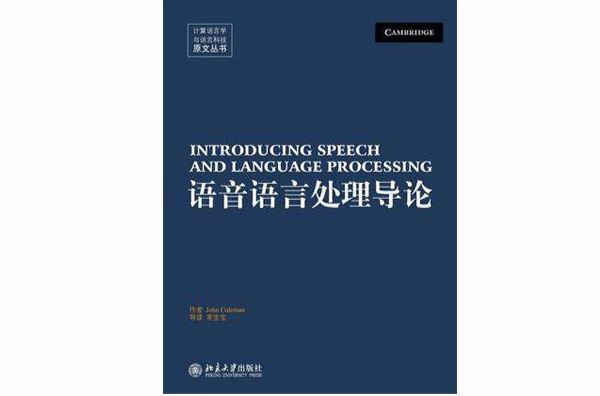《語音語言處理導論》是一本書籍,本書主要內容:中國國內中俄翻譯研究也不遑多讓,大約在上世紀50年代中期便已開始。可惜的是,這些中文相關早期機器翻譯研究,由於硬體與軟體的限制,沒能延續下來。中文計算語言學研究比較有系統的進展,還要等到1986年;海峽兩岸在同一年成立了兩個致力於中文計算語言學基礎架構建立的研究群。北京大學的計算語言學研究所在朱德熙先生倡導下成立,隨後一段時間由陸儉明、俞士汶主持。而台灣“中研院”的中文詞知識庫小組,由謝清俊創立,陳克健主持,黃居仁1987年返台後加入。
基本介紹
- 書名:語音語言處理導論
- 頁數:301頁
- 裝幀:平裝
- 開本:16
圖書信息,作者簡介,目錄,
圖書信息
出版社: 北京大學出版社; 第1版 (2010年8月1日)
外文書名: Introducing Speech and Language Processing
叢書名: 計算語言學與語言科技原文叢書
正文語種: 英語, 簡體中文
ISBN: 9787301171530
條形碼: 9787301171530
尺寸: 26 x 17 x 1 cm
重量: 458 g
作者簡介
作者:(美國)克勒曼(John Coleman) 合著者:常寶寶
目錄
導讀
Acknowledgements and copyright notices
1 Introduction
1.1 About this book
1.2 Purpose of this book
1.3 Some reasons to use this book
1.4 What's in the book (and what's not)
1.5 Computational set-up needed for this book
1.6 Computational skills that are necessary in order to use the book
1.7 Free software suggestions
1.8 Book structure
Sounds and numbers
2.1 Preparatory assignments
2.2 Solutions
2.3 Sampling
2.4 Quantization
2.5 The sampling theorem
2.6 Generating a signal
2.7 Numeric data types
2.8 The program
2.9 Structure of a loop
2.10 Structure of an array
2.11 Calculating the cosine values
2.12 Structure of the program
2.13 Writing the signal to a file
Chapter summary
Further Exercises
Further reading
Digital filters and resonators
3.1 Operations on sequences of numbers
3.2 A program for calculating RMS amplitude
3.3 Filtering
3.4 A program for calculating running means of 4
3.5 Smoothing over a longer time-window
3.6 Avoiding the need for long window
3.7 IIR filters in C
3.8 Structure of the Klatt formant synthesizer
Chapter summary
Exercises
Further reading
Frequency analysis and linear predictive coding
4.1 Spectral analysis
4.2 Spectral analysis in C
4.3 Cepstral analysis
4.4 Computation of the cepstrum in C
4.5 Pitch tracking using cepstral analysis
4.6 Voicing detection
4.7 f0estimation by the autocorrelation method
4.8 Linear predictive coding
4.9 C programs for LPC analysis and resynthesis
4.10 Trying it out
4.11 Applications of LPC
Chapter Summary
Further exercises
Further reading
Finite-state machines
5. 1 Some simple examples
5.2 A more serious example
5.3 Deterministic and non-deterministic automata
5.4 Implementation in Prolog
5.5 Prolog's processing strategy and the treatment
of variables
5.6 Generating strings
5.7 Three possibly useful applications o{ that idea
5.8 Another approach to describing finite-state machines
5.9 Self-loops
5.10 Finite-state transducers(FSTs)
5.11 Using finite-state transducers to relate speech to phonemes
5.12 Finite-state phonology
5.13 Finite-state syntactic processing
Chapter summary
Further exercises
Further reading
Introduction to speech recognition techniques
6.1 Architectures for speech recognition
6.2 The pattern-recognition approach
6.3 Dynamic time warping
6.4 Applications
6.5 Sources of variability in speech
Chapter summary
Further reading
Probabilistic finite-state models
7.1 Introduction
7.2 Indeterminacy: n-gram models for part-of-speech tagging ~
7.3 Some probability theory for language modelling
7.4 Markov models
7.5 Trigram models
7.6 Incompleteness of the training corpus
7.7 Part-of-speech model calculations
7.8 Using HMMs for speech recognition
7.9 Chomsky's objections to Markov models and some rejoinders
Chapter summary
Further reading
Parsing
8.1 Introduction
8.9 A demo
8.3 Intuitive parsing
8.4 Recursive descent parsing
8.5 The simplest parsing program
8.6 Difference lists
8.7 Generating a parse tree
8.8 Syllabification
8.9 Other parsing algorithms
8.10 Chart parsing
8.11 Depth-first vs. breadth-first search
8.19 Deterministic parsing, Marcus parsing and minimal commitment parsing
8.13 Parallel parsing
Chapter summary
Further reading
Using probabilistie grammars
9.1 Motivations
9.2 Probabilistic context-free grammars
9.3 Estimation of rule probabilities
9.4 A practical example
9.5 A limitation of probabilistic context-free grammars
9.6 Tree adjoining grammars
……

